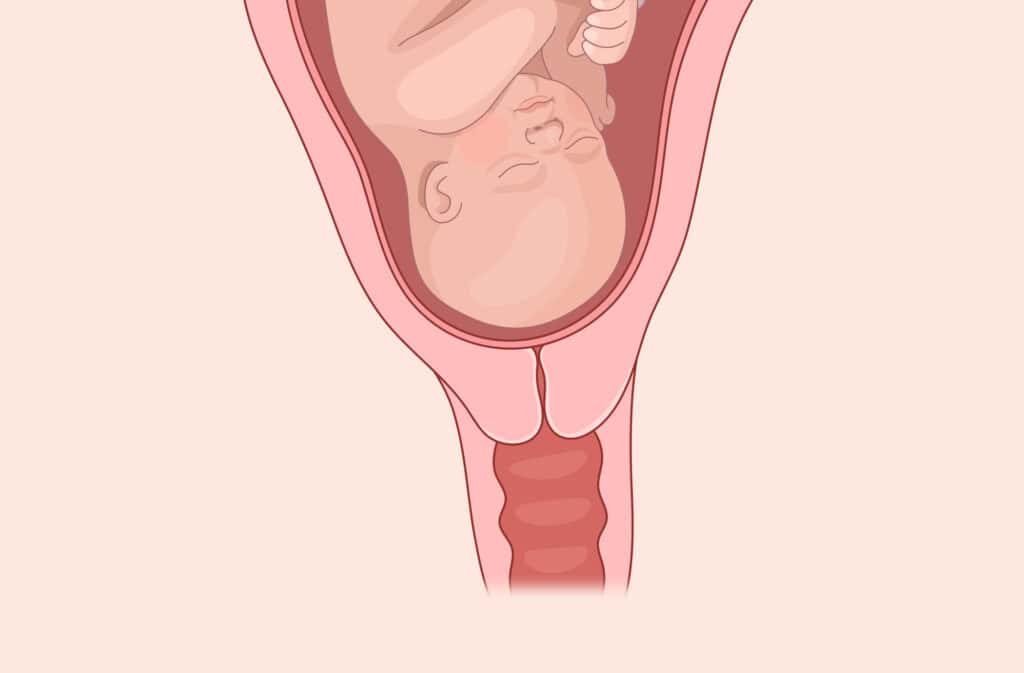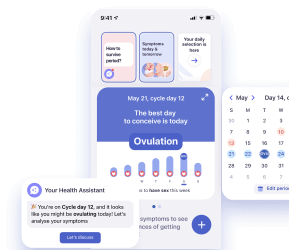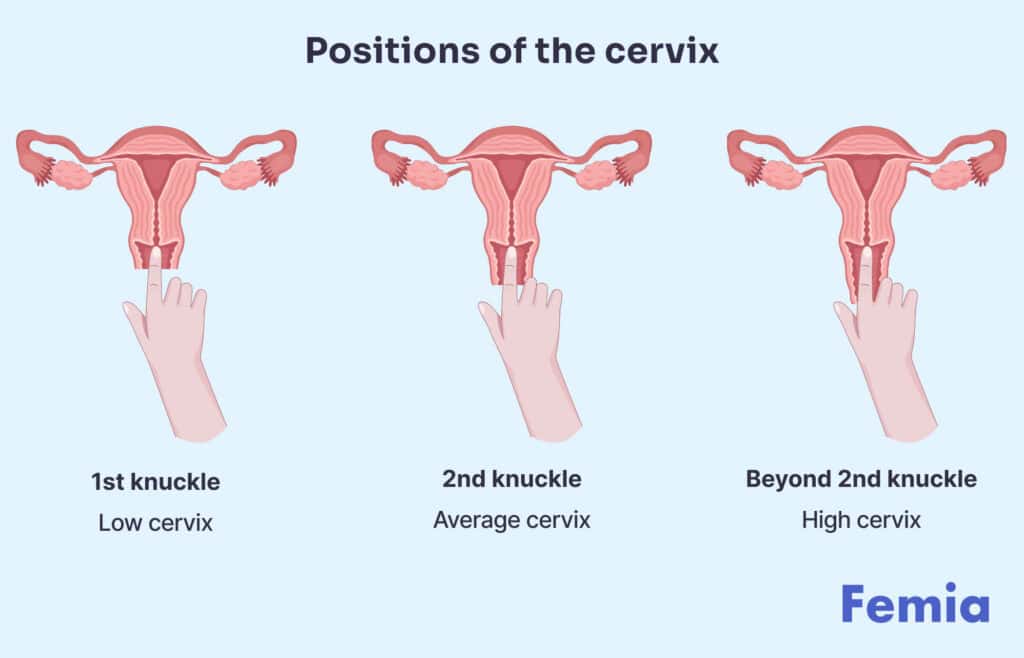Femia > Health Library > Getting Pregnant > Trying to conceive > How to check your cervix for pregnancy: A step-by-step guide
How to check your cervix for pregnancy: A step-by-step guide

- Updated Feb 25, 2025
- Published
CRAFTED BY HUMAN
Crafted by human At Femia, we provide accurate and up-to-date information at every stage of your journey, from trying to conceive, pregnancy and postnatal support. All content is created by a real person based on in-depth research and own professional experience. Femia ensures that you will receive expert advice, strict accuracy and a personalized approach from our authors/medical experts. Learn more about our editorial policy.
FACT CHECKED
Fact checked At Femia Health, we maintain the highest standards of editorial excellence in delivering content focused on helping you conceive, guiding you through pregnancy, and supporting you postpartum. Explore our content review principles to learn how we ensure the accuracy and quality of our health and lifestyle tips for every stage of your journey.
Your cervical texture and discharge changes during your menstrual cycle and pregnancy. These changes are more noticeable when you regularly check your cervix. After washing your hands, and finding a comfortable position you should be able to feel a soft cervix, that is closed, high up in your vagina during early pregnancy.
Your cervix connects your vagina to the uterus. It is a cylindrical band of tissue which can be felt high up in your vagina. Learning how to check your cervix can help you differentiate between phases of your menstrual cycle, early pregnancy, and labor.
The location of your cervix along with its patency (how open/unobstructed it is) can provide clues on when you are about to have your period or have recently conceived. While monitoring changes in your cervix is not a definitive way to confirm pregnancy (a blood test is), a routine check of your cervix throughout pregnancy can help relay important information and give you a heads up when to seek medical help if it’s required.

What is the cervix, and why check it for pregnancy?
Cervix, taken from Latin’s cervix uteri, describes the neck of the uterus. From most anatomical images, your cervix is donut-shaped, with a tight opening. Your cervix’s thickness, patency, and discharge changes consistently throughout your menstrual cycle. During pregnancy, the cervix undergoes changes based on hormones, increased blood volume, and the trimester of your pregnancy.
Some of the main functions of your cervix include:
- Release of menstrual blood
- Secretion of mucus based on hormonal signals
- Facilitation of sperm entry during ovulation
- Protection of your baby during pregnancy
- Dilation to provide passage during childbirth
👉Find out more: Bruised cervix symptoms: Causes, signs, and when to seek help
Positions of the cervix
Based on where you are in your menstrual cycle, the position of your cervix will differ. To know this difference you should check your cervix routinely every once in a while during your menstrual cycle.

Your cervix position on your period
During your period, your cervix is low in your vagina, and slightly open to allow for your menstrual blood to pass through. While it may not be ideal to check for your cervix position at this time, doing so in your luteal phase or a time close to your next period will give you an estimate.
Your cervix position during ovulation
After your period, and close to ovulation, your cervix can be found higher up in your vagina. You will also observe more cervical mucus being produced of an egg-white consistency. After ovulation, leading up to your period, your cervix will slowly descend into your vagina.
Your cervix position when you are pregnant
If you are pregnant, you will observe your cervix is higher up in your vagina. It has a soft consistency, remaining closed throughout pregnancy. You will observe changes in cervical mucus production as you progress in pregnancy, as blood flow and hormones increase in pregnancy. The patency (or lack thereof) of your cervix is a vital factor in a healthy pregnancy.
How to check your cervix at home?
You may have never previously considered checking your cervix. To do so, start with the basic hygiene practice of washing your hands and brushing under your nails. If you currently have an infection, such as a yeast infection or UTI, it would be best to wait for it to clear out before checking your cervix.
Once you have done this:
- Find a comfortable position. This can be done in your bathroom while lying on your bed, or sitting in a chair. For reference, the best positions are the ones that you use to insert your menstrual cup or tampon. Since your cervix is higher up in your vagina, you may need a more suitable position to prevent yourself from falling over.
- You can then insert either your index or first two fingers into your vagina in an upwards and backward direction.
- The higher you move into your vagina, you will eventually find your cervix. It is easier to locate when you are not on your period, or around ovulation, when you have increased cervical mucus.
Parameters to assess your cervix
After you have located your cervix you might want to assess the following during different phases of your menstrual cycle:
- Firmness of your cervix: Your cervix is softest during ovulation, allowing for the easy passage of sperm. Otherwise, during your menstrual cycle, your cervix can feel firm, similar to your nose tip.
- Open cervix vs closed cervix: This is checking whether your cervix is open or closed. Your cervix will feel slightly open during both ovulation and menstruation. An open cervix is soft and the opening will feel like a dimple. It may be difficult to decipher this at first, but with some practice, you should be able to easily feel the differences with your finger.
- Position in your vagina: As we have seen above, during the different phases of your menstrual cycle, your cervix will be felt in different positions inside your vagina.
If this is your first time, consider checking your cervix at the same time every day for one cycle. This will give you a baseline idea of the location, texture, and cervical discharge throughout your menstrual cycle. Avoid checking your cervix when aroused or soon after penetrative intercourse. This can obscure findings. Once you know your norm when it comes to your cervix, you can routinely check your cervix a few times a month for changes.
How does your cervix feel in early pregnancy?
You can check for changes in your cervix in early pregnancy soon after you have missed your period. Throughout pregnancy, especially early pregnancy, your cervix will be higher up in your vagina, and will feel soft against your fingers.
In the first trimester, a mucus plug is formed within the cervix. It is not easy to feel this plug, however, as your pregnancy progresses, the consistency of this plug will evolve and you will notice mucus mixed with your vaginal discharge, remnants of this plug.
Premature cervical opening, or release of the mucus plug is observed as a cause in 12.5% of premature deliveries.
👉Find out more: Mucus plug vs. discharge: Understanding the differences
Cervix before period vs pregnant: How to tell the difference?
The main differences in your cervix before your period and early pregnancy are in its position, consistency, discharge, and whether it is open or not.
| Before period | Early pregnancy | |
|---|---|---|
| Position | Moves low in the vagina before period | Remains high, similar to position during ovulation |
| Consistency | Feels firm | Feels soft, similar to a ripe fruit |
| Discharge | Minimal white, thick, and sticky discharge can be noticed before your period. | Hormones and blood flow can increase discharge. Some may notice early implantation bleeding. |
| Patency | Slightly open to allow for menstrual blood. | Closed, mucus plug formed in early pregnancy maintains the closed passage throughout pregnancy. |
It can seem overwhelming if you are unable to assess these cervical changes, especially if you have signs of early pregnancy. To be sure of pregnancy cervical consistency you should be able to know your baseline cervical texture during your menstrual cycle. Regularly checking your cervix can help with this. While these changes are an indication of pregnancy, you cannot use them as a confirmatory sign for pregnancy. Only a pregnancy test detecting hCG hormone levels either in your blood or urine works as a confirmatory test.
Cervix during pregnancy week by week
As we have seen, early pregnancy hormonal changes and an increase in blood flow make your cervix soft. Pregnancy hormone progesterone supports your cervix in remaining closed throughout pregnancy. Around the second month a mucus plug will help to keep the opening in your cervix closed for the length of the pregnancy.
Your cervix during pregnancy
Once your pregnancy progresses, and your baby bump increases, feeling for your cervix can seem like an extreme sport. This is completely normal. You can continue to assess your cervical discharge, watching for anything unusual such as blood, or changes in odor or color.
Your cervix when you are ready for delivery
Your cervix continues to remain closed until late into your third trimester. In the last few weeks, your baby will descend into your birth canal applying pressure on your cervix. This will cause your cervix to dilate and efface (thin out). Loss of progesterone-specific cells maintaining the closure of the cervix, favor shortening and dilation of the cervix.
During your weekly prenatal check-ups leading up to delivery, your obstetrician will routinely feel how your cervix is preparing for birth. Cervical dilation can start a few weeks before you deliver. Rest assured this is not an indicator of active labor. In some instances, cervix dilation can start on the day of labor. These cervical changes are individual to each woman, with many factors contributing, such as:
- Cervical changes in previous pregnancies
- Your baby’s position
- Size of your baby
- Hormonal fluctuations close to delivery
- The intensity of your contractions
In these final few weeks, it is best to avoid self-checking your cervix for dilation and effacement. The risk of infection is high at this time.
When to consult a doctor about your cervix
Early pregnancy cervical changes can be felt relatively easily. The changes are noticeable, especially if you have been checking your cervix regularly throughout your menstrual cycle. However, as your pregnancy progresses, routinely feeling for the changes in your cervix may not be feasible.
Along with changes in your cervix, if you have:
- Missed your period
- Nausea
- Breast soreness
- Fatigue
… consider consulting with your doctor as your first step. Your physician will start you on required prenatal checks and supplements beneficial for your pregnancy.
If you notice any changes to vaginal discharge, such as foul odor, blood, or greenish mucus, consult your healthcare provider. These signs, along with physical symptoms such as fever, profuse vomiting, chills, or significant bleeding often require prompt medical attention.

Questions from the Femia community
Will checking my cervix at home during pregnancy cause any harm?
Being gentle and using basic hygiene practices when checking your cervix during pregnancy shouldn’t cause any harm. However, regularly checking, can irritate the area, or in some cases increase your risk for an infection. If you feel something is amiss relating to your cervix during pregnancy it is best to inform your obstetrician and let them check it for you.
Can the position of my cervix confirm pregnancy without a test?
Feeling your cervix higher in your vagina and not in its regular position before a period is not sufficient to confirm pregnancy. While a high and soft cervix is a sign of early pregnancy, it is not confirmatory. These changes can also feel different for different women. A home pregnancy test following a missed period is more likely to give you an accurate answer.
Can checking my cervix tell me when I am ovulating?
Yes! If you regularly check your cervix during your menstrual cycle, you will notice specific cervical changes because of the ovulation hormone peak. During ovulation, your cervix will be high in your vagina, soft, and slightly open to allow for sperm to pass. You may also notice stretchy egg-white cervical discharge around ovulation.
The bottom line
Learning how to check your cervix can give you a picture of cervical changes throughout your menstrual cycle. This then makes it easier to notice the subtle changes in your cervix during early pregnancy. While these changes are distinctive for pregnancy, it is not a method to confirm pregnancy. A pregnancy test can do this.
Feeling for your cervix can help you to connect with the changes your body is going through during pregnancy. Ensure you practice basic hygiene whenever you check your cervix. If you feel or notice changes out of the norm, consider talking to your doctor for personalized care.
References
- Nott, James P., et al. “The Structure and Function of the Cervix During Pregnancy.” Translational Research in Anatomy, vol. 2, Mar. 2016, pp. 1–7. https://doi.org/10.1016/j.tria.2016.02.001.
- Becher, Naja, et al. “The Cervical Mucus Plug: Structured Review of Literature.” Acta Obstetricia Et Gynecologica Scandinavica, vol. 88, no. 5, Mar. 2009, pp. 502–13. https://doi.org/10.1080/00016340902852898.
- Timmons, Brenda, et al. “Cervical Remodeling During Pregnancy and Parturition.” Trends in Endocrinology and Metabolism, vol. 21, no. 6, Feb. 2010, pp. 353–61. https://doi.org/10.1016/j.tem.2010.01.011.
- Myers, Kristin M., et al. “The Mechanical Role of the Cervix in Pregnancy.” Journal of Biomechanics, vol. 48, no. 9, Mar. 2015, pp. 1511–23. https://doi.org/10.1016/j.jbiomech.2015.02.065.
- Larsen, Bryan, and Joseph Hwang. “Progesterone Interactions With the Cervix: Translational Implications for Term and Preterm Birth.” Infectious Diseases in Obstetrics and Gynecology, vol. 2011, Jan. 2011, pp. 1–13. https://doi.org/10.1155/2011/353297.
- Andersson, Stefan, et al. “Estrogen and Progesterone Metabolism in the Cervix During Pregnancy and Parturition.” The Journal of Clinical Endocrinology & Metabolism, vol. 93, no. 6, Mar. 2008, pp. 2366–74. https://doi.org/10.1210/jc.2007-2813.
- Li, Huanrong, et al. “Mixed Vaginitis in the Third Trimester of Pregnancy Is Associated With Adverse Pregnancy Outcomes: A Cross-Sectional Study.” Frontiers in Cellular and Infection Microbiology, vol. 12, Mar. 2022, https://doi.org/10.3389/fcimb.2022.798738.

What is precum? Find out everything you need to know about pre-ejaculatory fluid: when does precum occur and what is the chance of getting pregnant from precum?

Can sex induce labor? Read medical experts answer! Explore guide about best sex positions to naturally induce labor in a safe and effective way.

Learn how to sync your workouts with your menstrual cycle phases. Discover the best exercises for each phase to boost performance and energy levels.

